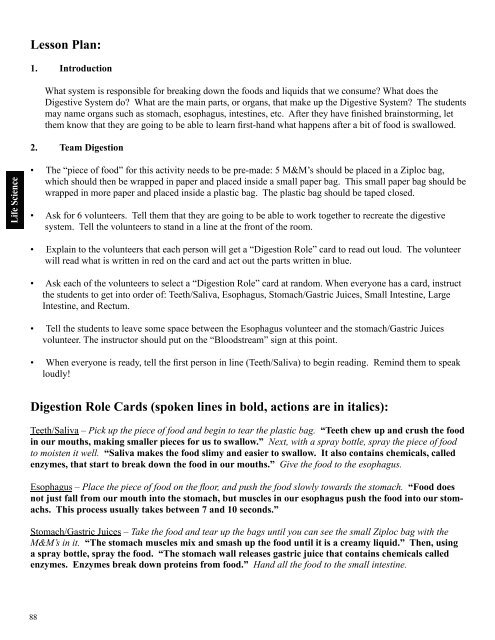ScienceMakers Toolkit Manual - The History Makers
ScienceMakers Toolkit Manual - The History Makers
ScienceMakers Toolkit Manual - The History Makers
Create successful ePaper yourself
Turn your PDF publications into a flip-book with our unique Google optimized e-Paper software.
Life Science<br />
Lesson Plan:<br />
1. Introduction<br />
88<br />
What system is responsible for breaking down the foods and liquids that we consume? What does the<br />
Digestive System do? What are the main parts, or organs, that make up the Digestive System? <strong>The</strong> students<br />
may name organs such as stomach, esophagus, intestines, etc. After they have fi nished brainstorming, let<br />
them know that they are going to be able to learn fi rst-hand what happens after a bit of food is swallowed.<br />
2. Team Digestion<br />
• <strong>The</strong> “piece of food” for this activity needs to be pre-made: 5 M&M’s should be placed in a Ziploc bag,<br />
which should then be wrapped in paper and placed inside a small paper bag. This small paper bag should be<br />
wrapped in more paper and placed inside a plastic bag. <strong>The</strong> plastic bag should be taped closed.<br />
• Ask for 6 volunteers. Tell them that they are going to be able to work together to recreate the digestive<br />
system. Tell the volunteers to stand in a line at the front of the room.<br />
• Explain to the volunteers that each person will get a “Digestion Role” card to read out loud. <strong>The</strong> volunteer<br />
will read what is written in red on the card and act out the parts written in blue.<br />
• Ask each of the volunteers to select a “Digestion Role” card at random. When everyone has a card, instruct<br />
the students to get into order of: Teeth/Saliva, Esophagus, Stomach/Gastric Juices, Small Intestine, Large<br />
Intestine, and Rectum.<br />
• Tell the students to leave some space between the Esophagus volunteer and the stomach/Gastric Juices<br />
volunteer. <strong>The</strong> instructor should put on the “Bloodstream” sign at this point.<br />
• When everyone is ready, tell the fi rst person in line (Teeth/Saliva) to begin reading. Remind them to speak<br />
loudly!<br />
Digestion Role Cards (spoken lines in bold, actions are in italics):<br />
Teeth/Saliva – Pick up the piece of food and begin to tear the plastic bag. “Teeth chew up and crush the food<br />
in our mouths, making smaller pieces for us to swallow.” Next, with a spray bottle, spray the piece of food<br />
to moisten it well. “Saliva makes the food slimy and easier to swallow. It also contains chemicals, called<br />
enzymes, that start to break down the food in our mouths.” Give the food to the esophagus.<br />
Esophagus – Place the piece of food on the fl oor, and push the food slowly towards the stomach. “Food does<br />
not just fall from our mouth into the stomach, but muscles in our esophagus push the food into our stomachs.<br />
This process usually takes between 7 and 10 seconds.”<br />
Stomach/Gastric Juices – Take the food and tear up the bags until you can see the small Ziploc bag with the<br />
M&M’s in it. “<strong>The</strong> stomach muscles mix and smash up the food until it is a creamy liquid.” <strong>The</strong>n, using<br />
a spray bottle, spray the food. “<strong>The</strong> stomach wall releases gastric juice that contains chemicals called<br />
enzymes. Enzymes break down proteins from food.” Hand all the food to the small intestine.










